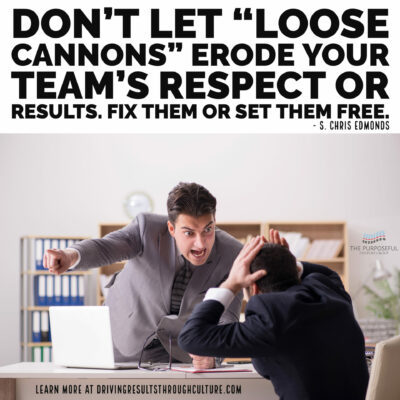Have you ever had a loose cannon in your company – a player that performs well but follows rules only when it’s convenient and treats others in the organization disrespectfully in most interactions?
This dynamic is difficult in any organization. And, if not proactively addressed, the impact this player has shifts from difficult to disastrous.
Here’s a typical loose cannon scenario.
Let’s call the perpetrator “Bob.” (In my 30 years of helping leaders with these challenges, I find that loose cannons are almost always male.)
What does Bob do that qualifies him as a loose cannon?
Bob generates results. He meets most if not all of the performance standards for his role. That’s a good thing.
Bob has positive relationships with customers. They feel they can depend upon him to deliver what they’ve asked for. That’s also good.
Bob has favorites on his team. The people he trusts, he treats respectfully. That’s OK.
Bob doesn’t participate in company meetings or celebrations. He’s (conveniently) not available to attend training sessions. That’s not good.
Bob believes that many people in the company don’t pull their weight. He consistently demeans, dismisses, and discounts their ideas, efforts, and contributions. That’s really not good.
Bob thinks the company’s efforts to build a values-aligned culture is horse manure. He mocks – to other company staff – the company’s messaging and coaching for everyone to treat others respectfully.
Everyone sees how Bob treats others. A steady stream of concerns and complaints are registered with Bob’s leader regarding Bob’s toxic behavior.
If you were Bob’s boss, what would you do?
Every boss I’ve coached in this situation wants to save the performance, to let Bob continue generating great results.
And, nearly every boss I’ve coaching in this situation underestimates the negative impact Bob has on both results and respect in the workplace.
One senior leader told me about his loose cannon, “This guy does 90% good things and only 10% bad things! We can’t throw out the good with the bad!”
The reality is that Bob’s negative impact on the business is far greater than 10%. Bob’s a great performer. Fine; Bob gets 50% credit for his contributions to results. Bob’s a bully. He get’s 0% credit on the other half of his job, which is “treating others respectfully.”
Firing Bob is something that is always on the table. Before we go to that last resort, we must offer Bob an avenue to genuine contribution AND respectful treatment of others. Coaching may not help Bob, but clear communication that the company will no longer tolerate Bob’s disrespectful treatment of colleagues – along with clear consequences – paves the the path for Bob to align or move on.
Consequences of Bob’s continued disrespectful treatment might include suspension without pay. Further bullying leads to the firm decision that Bob can’t work there anymore, and the process of dismissal begins.
Consequences of Bob’s improved, respectful treatment might lead to further coaching, validation that he’s on the right track, and a clear message that improvement is the only pathway to maintaining his role in the company.
This approach can change a loose cannon into a talented, committed team player who equally contributes results and respect.
This is episode ninety-one in my Culture Leadership Charge series. Most episodes include a short video and podcast. This month I had disk fusion surgery so the video and podcasts were set aside. I’ll resume both again next month (possibly in a neck brace!).
You’ll find my Culture Leadership Charge episodes and more on my YouTube, iTunes, and Amazon Podcast channels. If you like what you learn, please subscribe.
Have you responded to this month’s culture leadership poll? Add your ratings to two questions. It’ll take less than a minute. Once you vote, click “results” to see the responses from around the globe.
Photo © Adobe Stock – Elnur. All Rights Reserved.



